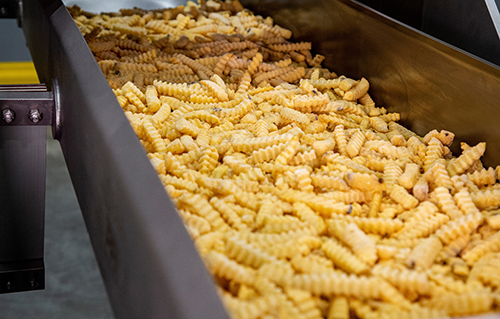A processing plant’s conveyors touch food at every point of production, from receiving to packaging to before and after critical processing stages including slicing, thawing, pasteurizing and cooking. Today’s food-grade sanitary conveyors are built to protect the spread of bacterial contamination that can cause foodborne illness. But what do sanitary conveyors do, and how do they contribute to food processing plant safety?
How Sanitary Conveyors Work
Conveyors move ingredients and products between processing stages in any production plant. They ensure the different plant applications are integrated into a single process and automate handling challenges such as lifting, lowering or reorienting product for further processing.
In food manufacturing, conveyors are critical as they allow large amounts of product to be processed quickly and efficiently, but they also perform another crucial function: ensuring food safety. Conveyor equipment must maintain the same food hygiene standards as the rest of the plant.
Sanitary Conveyors and Food Safety
Bacterial contamination is the most serious threat to food safety when consumable products are handled in bulk. Harmful bacteria can proliferate when food becomes trapped or equipment is improperly sanitized and can spread quickly through any exposed product.
Food-grade conveyor equipment is designed to avoid contamination of products. Modern conveyor food processing systems include food-safe components and special features designed to maintain hygiene to prevent dangerous bacteria from contaminating products and limit their ability to spread.
Sanitary conveyor equipment also helps protect products by:
- Limiting the time food is exposed to potential contamination
- Combining and reducing processing steps to minimize handling
- Matching handling techniques to specific products
Today, food-grade conveyors provide effective sanitary control while offering a full range of handling solutions that can be customized to the needs of a product or the constraints of a production space. These include:
- Belt conveyors for flexible, seamless line integrations
- Bucket and incline conveyors for raising product in motion
- Tote dumpers for safe, efficient bulk handling
- Horizontal motion conveyors for loose or granular products
- Vibratory conveyors for cooked foods
Food Contamination Costs Brands Millions
Food-safe solutions designed with a manufacturer’s product and processes in mind are critical when considering the true cost of a food safety failure or product recall.
The CDC estimates that sicknesses caused by foodborne pathogens affect 48 million Americans yearly, with up to 128,000 people hospitalized with bacterial pathogens such as campylobacter, listeria, salmonella, and E. coli. Increasingly sophisticated industry monitoring means manufacturers are subject to ever-higher hygiene standards and more sophisticated contamination tracing techniques.
Today, even a limited product recall can cost a brand up to $10 million. The cost of downtime and lost product of a complete line shutdown to deep clean, sanitize and test equipment can be far higher. In addition, the indirect costs to a business can be challenging to measure but are just as real. These can include:
- Damage to the brand
- Damage to the company’s reputation
- Loss of public confidence in the product category
- Loss of key staff
- Lower workforce morale
Today’s Food Safety Standards
To minimize the risk to consumers and the food system as a whole, regulators and industry groups require food processing equipment, including sanitary conveyors, to meet a wide range of standards. Common standards in the U.S. today include:
- Consumer Brands Association (CBA) — (formerly Grocery Manufacturers Association)
- American Bakers Association (ABA)
- North American Meat Institute (NAMI)
- USDA
- FDA
- ISO 22000
Compliance with these standards is enforced by regular equipment inspections and testing. Typically, any food-exposed surface must pass a rigorous surface-swab test to meet sanitary requirements.
Safety standards are also constantly improving. For example, the FDA Food Safety Modernization Act is being rolled out and will raise standards significantly in several sectors.
Ensuring Food Safety with Sanitary Conveyors
How does today’s food-grade conveying equipment help protect food safety? Here are four examples:
Minimize handling. Perhaps the biggest contribution conveyors make to food safety is minimizing the amount of physical handling products receive. Reducing the need for human contact with food significantly reduces the risk of contamination. Because different types of conveyors can move, raise, lower and change the direction of travel, the need for human handling of food is often eliminated. Some equipment, such as horizontal motion conveyors, can even slow down or reverse direction to allow parts to be cleaned or replaced without stopping the line.
Match technology to process. Choosing the suitable conveyor for a product or process is critical to maintaining a consistent level of hygiene. For example, vibratory conveyors are best for preventing the sticking of cooked food, while horizontal motion conveyors keep frozen product like seafood moving. Experienced equipment providers can help match conveyor equipment to the manufacturer’s specific needs.

Use sanitary materials. The best food-grade conveyor equipment is made from high-quality, hygienic materials. To minimize the risk of contamination, any surface that comes into contact with food must be:
- Smooth and free of cracks, crevices or dents
- Nonporous and nonabsorbent
- Non-reactive to food products
- Corrosion resistant
- Require little or no maintenance to maintain these characteristics. (This applies particularly to painted, coated or electroplated surfaces. There should never be any flaking, bubbling or chipping of food-exposed surfaces.)
To preserve hygiene, most leading brand manufacturers of sanitary conveyors choose either FDA-approved food-grade plastics for belting or bucket systems and a range of metals for contact surfaces, depending on the application.
While a range of metals might be appropriate for applications handling dry materials such as hard candy or pasta, processors handling dairy and meat products must meet much tighter sanitary standards. In these sectors, true food-grade stainless steel is preferred for its naturally antimicrobial properties and resistance to high-temperature washdown, pasteurization and sterilization procedures.
Designed for safety. The design of professional-grade food conveying equipment takes sanitation into consideration. Today’s systems include minimal moving parts. Keeping the design of machinery simple has several benefits, including:
- Makes it easier to clean, maintain and sanitize
- Reduces wear and tear to minimize downtime and maintenance calls
- Fewer connections and other potential contamination points
- Key components are easier to access for cleaning and maintenance
- Simplifies sanitation and validation processes
Simpler equipment also enables the toolless replacement of key components, reducing the likelihood of damage or contamination of a production line by non-sterile maintenance tools.
In addition, newer conveyor systems offer active water and condensation management, which minimizes moisture accumulation and actively manages liquids released by cooking, draining and dewatering. These systems feature:
- Angled surfaces
- Tilted or grooved belts and conveyor surfaces
- Self-draining piping systems
Food processors should look for features that minimize water ingress between components for equipment exposed to high-temperature washdown and sterilization processes, such as conveyors handling dairy or raw meat products. Look for:
- Solid stainless steel tubing
- Minimal unwelded joints, crevices or fasteners
- IP69K compliance: the top industry standard for limiting water ingress between parts
Simple design, premium materials and quality construction all help to minimize food-exposed places where bacteria can build up. They also make it easier to swab-test and validate equipment. Features include:
- Properly designed and installed fasteners
- Tight, overlapping joints and connections
- Smooth, polished welds and well-milled contact surfaces
- Radiused corners without welds
In addition, look beyond direct contact surfaces when checking for harboring opportunities. Look carefully at the top edges and contact points with coverings or lids where moisture or waste could accumulate.
Value-Added Sanitary Conveying
Value-added technologies or features processors should consider when choosing conveying equipment include:
Combining/Eliminating Processes. Advanced equipment such as vibratory conveyors offer value-added processing that allows product to be laned, spread, dewatered or reoriented while in motion, providing the ability to combine or eliminate processes that were previously separate steps. Fewer steps mean less handling or exposure time for vulnerable materials like sliced fresh produce, raw meats or cheeses.
Improved Quality Control. Variable-speed horizontal motion conveyors allow finished products to be more easily inspected on moving trays before final packaging, enhancing the output quality and allowing more opportunities to spot substandard product.
Clean-in-Place. Premium conveying equipment is generally customized for specific applications and may include features such as clean-in-place equipment. This allows food-exposed surfaces to be cleaned or to self-clean while the machine is still operating.
Value-added equipment such as belt scrapers, flip-down guarding, belt lifts and quick-release take-ups minimize hands-on maintenance, helping to ensure sanitary conditions for longer periods of time.
Ensuring food safety is a top priority for processors, and sanitary conveying equipment plays a role in protecting both the processor and the consumer. Choosing high-quality equipment that fits into a plant’s design and set up and is easy to clean and sanitize helps create trust in brands while also impacting the bottom line.





